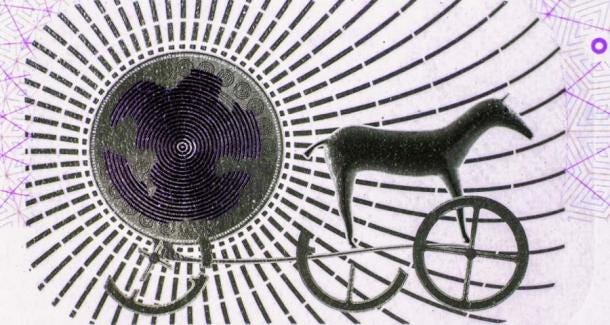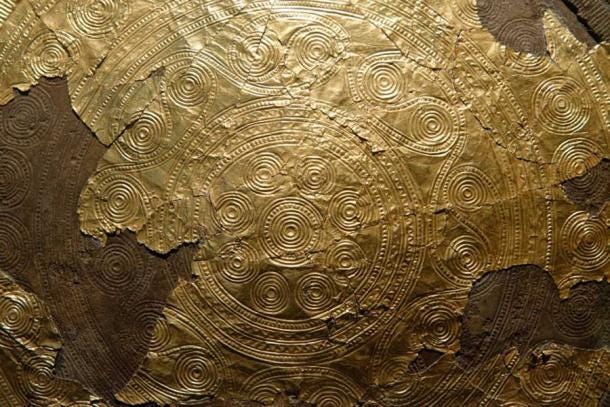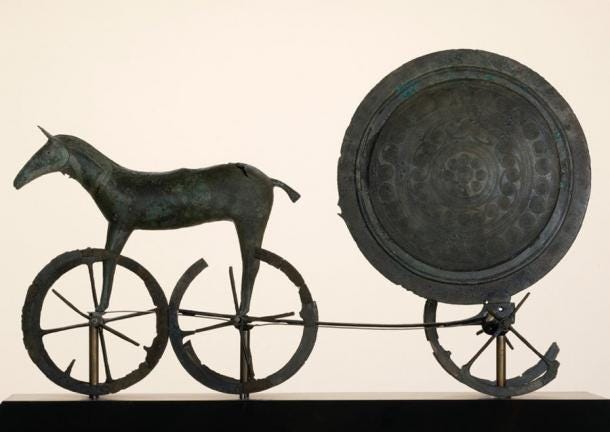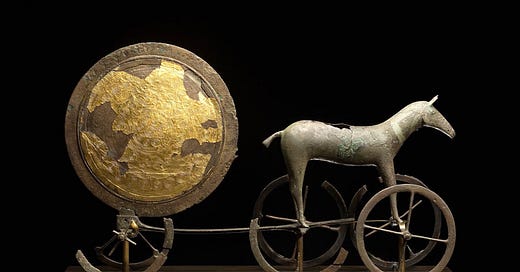The famous Trundholm Sun Chariot is a bronze and gold artifact pulled out of a bog in Denmark in 1902. Said to belong to the Nordic Bronze Age (c. 1700 to 500 BC), the so-called chariot consists of a bronze horse, a bronze disc with a thin sheet of gold pressed into one side, and six four-spoke wheels made also of bronze.

The Unexpected Discovery of the Trundholm Sun Chariot
The Norse artifact was first discovered on the coast of the southern Danish island of Zealand ( Sjælland) back in 1902. A farmer found it in the mud while ploughing a peat bog known as Trundholm Mose. Initially he believed it was a toy, but ended up contacting the National Museum of Denmark. And a lucky thing too! The Trundholm Sun Chariot is now a Danish national treasure, and was even included on the 1,000-krone banknote.
Believed to have been created around 1400 BC, the artifact is over 3,400 years old and according to the National Museum of Denmark it is “one of southern Scandinavia’s earliest examples of the horse being used as a draught animal.” Experts have concluded that the Trundholm Sun Chariot was created using what is known as the lost wax method, or cire perdue .
The Sun disk was decorated with spirals, a common motif in true Nordic craftsmanship. One side was gilded, to give the impression of the sun during the day, while the other side was left dark as way of depicting the journey of the sun during the night.
In 1998, almost 100 years after the artifact was first discovered in the peat bog , experts returned to the find spot of the famed Trundholm Sun Chariot with a metal detector. During this archaeological dig, they unearthed 21 additional parts, which have allowed conservationists to reassemble a more complete picture of how the object must have looked originally.

The Trundholm Sun Chariot as Ritual Performance
World Archaeology argues that the importance of the Trundholm Sun Chariot lies in the fact that it is “perhaps the finest example of a crucial aspect of Scandinavian Bronze Age religion: the cosmic passage of the sun through heavenly light and the darkness of the underworld.” In other examples discovered in Scandinavia, the horse is replaced by ships or fish, amongst other creatures.
Within these prehistoric Norse Bronze Age beliefs, the horse was said to pull the sun over the heavens during the day and through the darkness of the underworld during the night. Historians believe that the artifact was used by priests of the era when performing their rituals, to illustrate the voyage of the sun.
In spite of the fact that this Nordic Early Bronze Age artifact it has been called a chariot since its discovery, it may not actually be one. The wheels themselves were probably used to enable the sun and horse to be drawn along in a ceremonial procession or ritual performance, rather than being the wheels of a chariot.
This is deduced based on slightly later depictions of the Sun on rocks and small metal gear from northern Europe. In these images, the Sun is presented as a disc or a single wheel drawn by an animal or bird, rather than travelling across the heavens in a cart or chariot.
The approximate size of the whole object, however, is 54 cm long, 35 cm high and 29 cm deep, which seems rather small for an object used in a ceremonial procession or ritual performance. Perhaps the wheels served a practical function by keeping the horse and disc standing upright.

Was the Trundholm Sun Chariot Actually a Calendar?
Apart from being a ritual object, it has also been suggested that the Trundholm Sun Chariot may have functioned as a calendar. This theory was proposed by Klaus Randsborg, a professor of archaeology at the University of Copenhagen, who explained that the golden day-side of the Trundholm Sun Chariot has dimensions associated with one third of a solar year.
Meanwhile, Ransborg argues that the night-side of the large central concentric circle has dimensions linked to six lunar months. He therefore concluded that “the reference is to the Sun-calendar on the day-side, and to the Moon-calendar on the night-side of the Sun Chariot, which seems the perfect calculation.”
According to Amelia Carolina Sparavigna, assistant professor at the department of physics of Turin's Polytechnic University, the two sides of the sun disk represent the sun as it is drawn across the heavens from East to West during the day, presenting its bright side to the Earth and then returns from West to East during the night, when the dark side faces Earth.

Sun Chariots in Mythology
Comparisons of the Trundholm Sun Chariot with actual sun chariots from the mythology of other cultures are not quite accurate, taking into account that the former is not a chariot at all. Nevertheless, it can be said that there is a common belief amongst ancient cultures that the Sun travelled across the sky.
Apart from Norse, Celtic, and Hindu mythology, “travelling Suns” also appear in ancient Egyptian and Greek mythology . For example, in Egyptian mythology, the Sun is represented as being transported across the sky by Ra’s solar barge, or pushed by Khepri, a god depicted as a scarab. Due to the importance of the Sun as a life-giving force, it is not too difficult to understand why the ancients perceived the Sun as a divine .
The Trundholm Sun Chariot is an incredible artifact. Whether it was a calendar or not is probably something that we will never know. However, its similarity with solar imagery of other cultures shows a certain sense of commonality, albeit expressed differently, by human societies.
Top image: The gilded side of the Trundholm Sun Chariot. Source: CC BY-SA 3.0
By DHWTY
References
Gelling, P. & Davidson, H. E. 1969. The Chariot of the Sun, and Other Rites and Symbols of the Northern Bronze Age. London: J. M. Dent & Sons Ltd.
Randsborg, K. 2010. “SPIRALS! Calendars in the Bronze Age in Denmark” in Adoranten. Available at: http://www.rockartscandinavia.com/images/articles/randsborga9.pdf
Sandars, N. K. 1985. Prehistoric Art in Europe. 2nd ed. Harmondsworth: Penguin Books Ltd.
Sparavigna, A. C. 2012. “Ancient bronze disks, decorations and calendars” in arXiv: Popular Physics .




Thanks for this very interesting article.
Archaeologists and other academic scholars have the Trundholm scenario to deal with the Sun, but when our ancestors were looking at the celestial day- and night scenarios of the Sun, the Moon, the Stars and Star Constellations, there is no natural or logical way they could have got an imagery of a horse drawn chariot to fit with the Sun.
Such an interpretation derives from a scholarly lack of astronomical and cosmological insight and knowledge.
- The Sundholm wheels speaks in general of a "rotation around a center", and the only natural and logical possibility here is the starry motion in the night sky and the Earth´s rotational celestial pole axis.
Imaging this celestial pole axis center as a circle or a wheel around which stars and star constellation rotate, a close by constellation are imagined by our ancestors to draw this circle around and of course the Canis Minor or Little Dipper is directly connected to this central point, but even the Canis Major or Big Dipper constellation could be a possible imagined origin to "an animal drawn wagon".
The Earth´s celestial axis pole circle symbolism is carved in Rock Arts all over the World and connected to both animals, human like figures and even to the whitish crescent contours of the Milky Way, which constitutes a stylized carved figure of a "ship", "sailing" around on the pole axis in the night Sky.
The spiralling figures on the Disk describe in my firm conviction a very connected formation of everything and especially connected to the Milky Way which mythologically is included and described in the numerous cultural and very similar Stories of Creation.
Logically, the same celestial scenario is carved very similarly by all ancestral cultures over different continents and under the Earth´s hemispheres.
Links: from my personal website:
The celestial Circle and Wheel - http://www.native-science.net/NorthPole.Centre.htm
Milky Way Man and Ship - http://www.native-science.net/MilkyWay.Contours.htm
Carved Star Constellations - http://www.native-science.net/Stars.Constellations.htm
And lot of other information too.
Regards
Ivar Nielsen
Comparative Mythologist & Natural Philosopher
Denmark
Looks like an egyptian eye in the center if u pinch zoon the 1st pic.. interesting